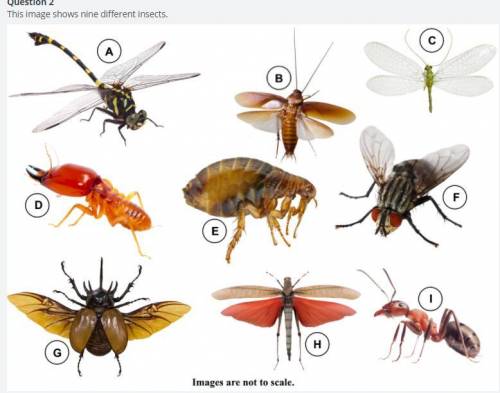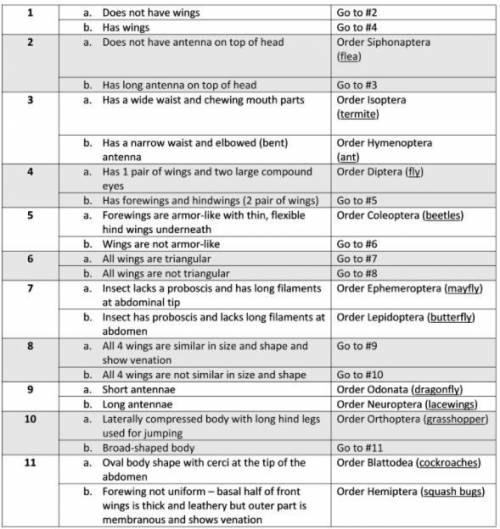
Biology, 04.05.2021 23:10 Angela1998
Use this dichotomous key to identify the taxonomic order of each insect. (Hint: All of the insects belong to different orders). The information for the first insect has been completed for you.



Answers: 2


Another question on Biology

Biology, 21.06.2019 20:30
The collared lizard is a species found in the desert southwest. male collared lizards show considerable color variation, ranging from brightly colored to a very dull pattern. your goal is to determine the function, if any, of male color patterns in collared lizards, using the scientific method. your tentative explanation is that male color plays a role in attracting females for mating purposes. you predict that females will preferentially choose brightly colored males over dull-colored ones. to test this prediction, you observed the interactions of female collared lizards with their male counterparts. you selected males that were the same age and size, and that differed only in their coloration pattern. you placed equal numbers of the two types of male lizards, bright and dull, in aquariums, along with one female lizard per aquarium. out of 350 aquariums observed, the female chose to mate with the brightly colored male 277 times, and the dull-colored male 70 times. in 3 instances, the females did not mate with either type. create a bar graph of your data, plotting the type of male (dull or brightly colored) on the x-axis. on the y-axis, plot the frequency with which each type of male was chosen by females. using this graph, answer the following question(s). is it reasonable to conclude (i.e., is it supported by the data) that female collared lizards prefer more brightly colored male lizards over dull-colored males?
Answers: 3

Biology, 22.06.2019 01:30
Scenario 5 1) take 10 red and 10 black beans and place them, mixed, on the table. record the starting phenotype # and frequencies (% of your total population) of your starting population in the table provided (generation 0). 2) act as a predator. “capture” as many organisms as you can until you have reduced the population to three organisms. put them aside. at this point, the predators die. 3) the remaining organisms each produce 2 clonal offspring. multiply your organisms accordingly and allow them to mix on the table. calculate and record the resultant phenotype # and frequencies (% of your total population) of your population in the table provided (generation 1). 4) repeat the reproduction event, allowing each of your organisms to produce 2 clonal offspring. calculate and record the resultant phenotype # and frequencies (% of your total population) of your population in the table provided (generation 2). 5) repeat the reproduction event, allowing each of your organisms to produce 2 clonal offspring. calculate and record the resultant phenotype # and frequencies (% of your total population) of your population in the table provided (generation 3).
Answers: 1

Biology, 22.06.2019 06:00
Which is one example of a phenotypic change that is not genetic
Answers: 3

Biology, 22.06.2019 07:00
An ecologist studied the same species of deer during the summer and the winter. she noticed that during the summer, when there was plenty of food, the deer were energetic and playful. however, during winter when food was scarce, the deer moved more slowly and did not run unless they needed to escape a predator. which scientific fact is best supported by her observations?
Answers: 3
You know the right answer?
Use this dichotomous key to identify the taxonomic order of each insect. (Hint: All of the insects b...
Questions


Mathematics, 20.11.2020 04:40

Chemistry, 20.11.2020 04:40




History, 20.11.2020 04:40

Spanish, 20.11.2020 04:40




Mathematics, 20.11.2020 04:40

French, 20.11.2020 04:40

Biology, 20.11.2020 04:50


Chemistry, 20.11.2020 04:50


Mathematics, 20.11.2020 04:50

Physics, 20.11.2020 04:50

Mathematics, 20.11.2020 04:50



